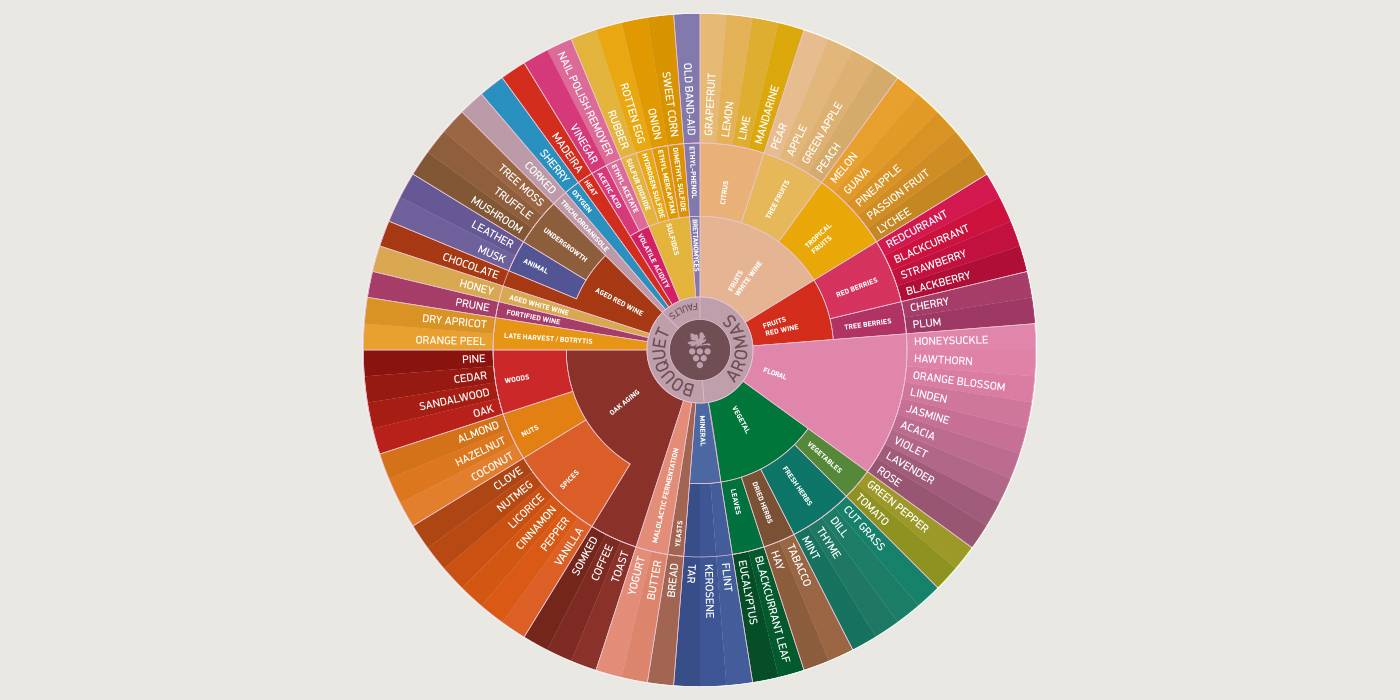Aromas of wine: Understand their classification
Do you know what the aromas of wine are? There are up to three different types. Discover the nuances that exist in each one and what characterises them.

Eva Pizarro
Sommelier at Fierro restaurant and trainer at Tandem Gastronómico.
During my sommelier classes at university, on sommelier students’ first day I am still surprised how they think that wine bouquets are ingredients added by winemakers.
Almost as if it were a perfume; we add a touch of lemon, strawberry, rose petals, and
Voila!
The fact is that wine is still a rather unknown entity. We are going to tell you everything you need to know about wine bouquet.
Where does wine bouquet come from?
Wine bouquets come from and are produced at different moments during the winemaking process:
The primary bouquet comes from the grapes, and is different depending on the variety.
There are estimated to be over 5000 grape varieties in the world. In Spain around 250 have been recorded, each of them with different bouquets, and therefore this is one of the key factors affecting the resulting wine.
Furthermore, these bouquets change depending on where the vines are planted. In colder regions, the bouquets are fresher, whereas in warmer areas, they tend to be riper. They vary depending on the weather each year, the moment when the grapes are picked, how ripe they are, and how the vineyard has been worked, the soil, etc. (see the article on climate and wine on the Consum website).

Some grapes are fairly easy to identify, and blind tasting is one of the hardest exercises, but it is also one of the most entertaining. They are the so-called terpenes which contain many, well-defined bouquets, such as:
- Moscatel: roses, citrus fruits, jasmine, lychee, etc.
- Riesling: lemon, honey, apricot, acacia and these grapes also develop hints of kerosene after long periods of ageing.
- Gewürtztraminer: violets, roses, musk…
In red wines, the following stand out:
- Cabernet Sauvignon: blueberries, blackberries, green pepper, eucalyptus...
- Pinot Noir: cherries, violets, strawberries, cassis...
- Tempranillo: raspberries, blackberries, blueberries, dark plums...
So why does some wine smell like peaches? Or pineapple? Or raspberry even?
The answer to this is that they all share common olfactory molecules. Mystery resolved! No, we don’t add fruit or flowers to wine.

Bouquet also comes from the winemaking process of the must, the secondary bouquets are from fermentation and the transformation of bacteria that this involves. This takes place when the sugar in the must is transformed into other substances (alcohol, aldehyde, ketone and acid) by the yeast and other micro-organisms in the air. These bouquets depend on factors such as the temperature at which fermentation takes place, and are the result of many molecular reactions leading to different compounds and different bouquets
- Fermentation: yeast, breadcrumbs, brioche, bakery...
- Malolactic fermentation (you can find out more about this process in the article on malolactic fermentation on our website): milk, yoghurt, butter, fresh cheese or yeast, among others.
- Amyl: caramel, banana, acetone, varnish...
Finally, the tertiary bouquets: these are produced by ageing wine in barrels and in bottles. During this process, the bouquet in wine intensifies and diversifies, leading to new components. We can find a number of bouquets such as:
- Animal: leather, game, meat, ink, nuts…
- Balsamic and wood: resin, wood, spices, vanilla, coconut…
- Empyreumatic: tobacco, smoke... It is at this point when the bouquet is defined, which in wines aged in contact with the air is called oxidation bouquet, and in wines aged with an air seal and in the bottle, it is called reduction bouquet.
If you want to learn to be a master wine-taster, we are giving you the bouquet wheel, through which you will learn to name what you perceive in wine.

What do you think about?
Share comments, opinions and tricks with the Community







